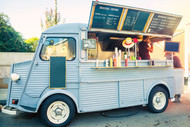What Generator Do I Need for a Food Truck/Coffee Van?
20th Jun 2019
Work out what appliances will you use during the day?
Understanding how your equipment will function when powered by a generator is important to prevent your truck / van operations from stalling. Some appliances need a higher starting wattage (required power to start up) compared to its running wattage. You need to know the kind of load your generator will be powering so you can calculate how much power (and the size of generator) you will need.
There are two kinds of loads:
Resistive loads – require the same amount of power to start up and run. These are appliances usually involved in heating or produces heat like light bulbs, coffee makers, toasters, and microwave ovens.
Reactive loads – require additional power to start but consumes less once it is running. These are appliances that contain an electric motor like refrigerators, bean grinders, blenders, and air conditioners.
How much power do you need?
A generator can only produce a certain amount of electricity so make sure to choose a model that will be able to cover your food truck’s power requirements.
To know how much power your generator should have, calculate the power requirements of all the appliances you will be using at the same time. You can determine the power required by an appliance by checking the bottom or side for a stamp, its nameplate, or the data tag found on electric motors. Manuals also contain these information.
Power requirements of appliances are usually listed in amps while most generators list power outputs in watts so a bit of conversion might be required.
Conversions:
Watts = Volts x Amps
Amps = Watts / Volts
To calculate: Add the power requirements of the appliances you will use at one time. This will give you the amount of power your generator should at least have. If the load is reactive, calculate using starting wattage, which is typically 3 times the running wattage.
Example calculation: (using estimated power requirements)
Coffee maker – starting wattage: 600; running wattage: 600
Refrigerator (Energy Star) – starting wattage: 1200; running wattage: 192
5 Lights bulbs – starting wattage: 300; running wattage: 300
Blender – starting wattage: 850; running wattage: 400
Total: 2950W
You will need a generator with a continuous power output of at least 2950 watts. Getting a generator with a slightly higher wattage output than your requirement is recommended; some appliances increase their need for energy as they age and become less efficient.
Honda Generator In addition, generators are advertised with “maximum power” and “rated power / continuous power.” Maximum power is the highest wattage a generator can produce and usually available for up to 30 minutes. Rated power is the power a generator can produce for extended periods of time, which is typically 90% of maximum power. Use rated power in determining whether a generator will be able to provide your food truck with enough energy to operate your equipment.
The most common size generator we sell for the food / coffee van application is the Yamaha EF6300iSE or the Honda EU70iS, both being a inverter generator.
What type of generator should you choose?
Conventional vs Inverter Generators
There is a wide variety of generators for vendors to choose from but models fall into two categories: conventional generators and inverter generators.
Conventional Generator
basic concept has remained essentially unchanged
uses a motor attached to an alternator producing AC power, mounted into a rollover frame
engines runs at high speed (usually 3600 rpm); fluctuation in engine speed affects output
cannot be used in parallel operation
larger and heavier than inverter generators
less expensive than inverter generators
Inverter Generator
most advanced generator made to date
uses advance circuitry to convert multi-phase AC power to DC power then inverts to “cleaner” AC power
can adjusts engine speed depending on load requirement - therefore great fuel efficiently
smoother electrical signal; safer for sensitive equipment (laptops and phones)
fuel efficient
portable and lightweight
produces less noise and vibration
capable of parallel operation with multiple units
more expensive than conventional generators
Most operators prefer to use inverter generators for the smoother energy output, portability, fuel efficiency, and quiet operation despite the higher price compared to conventional generators.
There are many different models of generators out on the market today. Some of the most popular and the models we recommended are made by Honda and Yamaha. They are easily the top two manufactures of conventional and inverter generators in the world.
They are both backed by Australia Wide with service agents in most major towns.
Also remember for something you are going to rely on everyday to run your business, a good quality generator, serviced regularly will never let you down.





